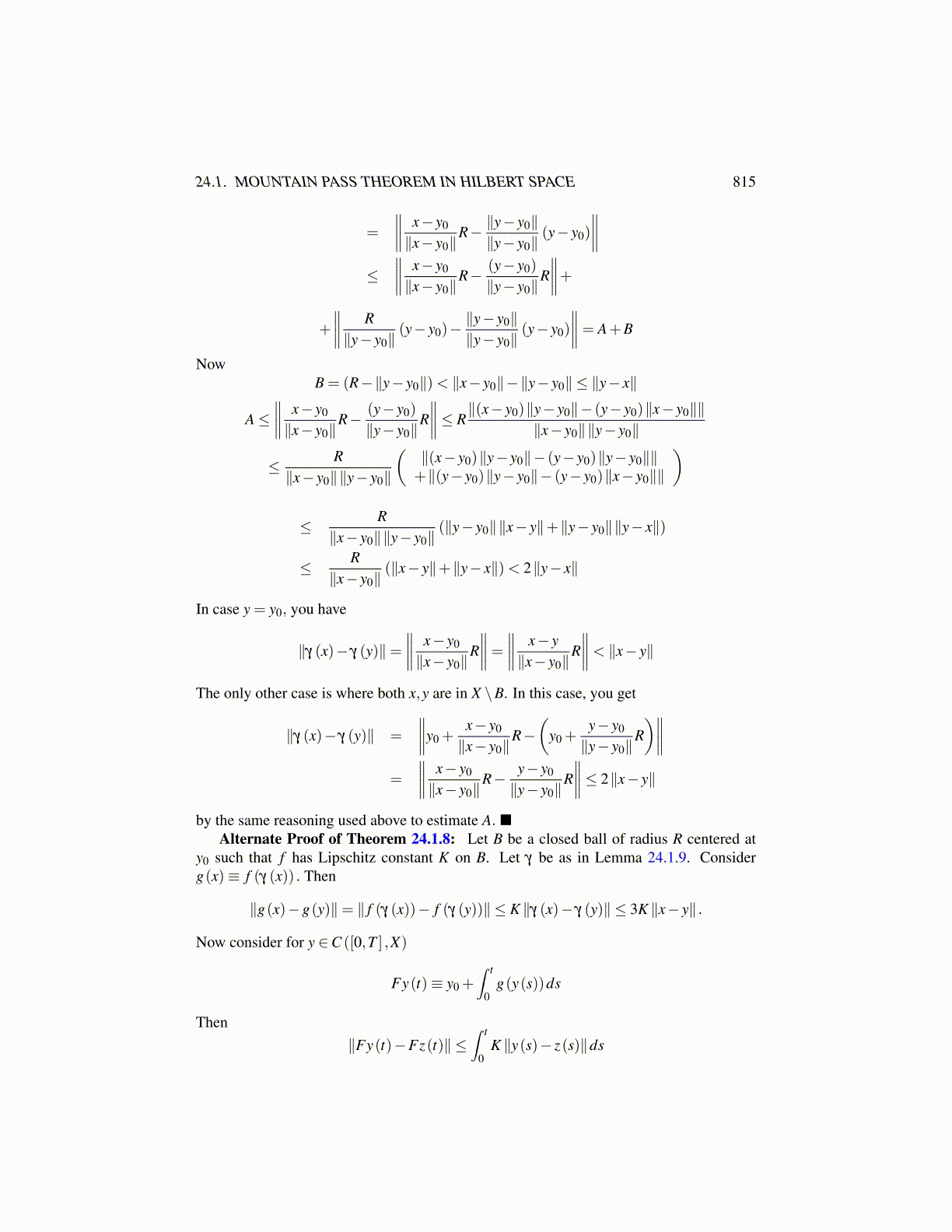
24.1. MOUNTAIN PASS THEOREM IN HILBERT SPACE 815
=
∥∥∥∥ x− y0
∥x− y0∥R− ∥y− y0∥∥y− y0∥
(y− y0)
∥∥∥∥≤
∥∥∥∥ x− y0
∥x− y0∥R− (y− y0)
∥y− y0∥R∥∥∥∥+
+
∥∥∥∥ R∥y− y0∥
(y− y0)−∥y− y0∥∥y− y0∥
(y− y0)
∥∥∥∥= A+B
NowB = (R−∥y− y0∥)< ∥x− y0∥−∥y− y0∥ ≤ ∥y− x∥
A≤∥∥∥∥ x− y0
∥x− y0∥R− (y− y0)
∥y− y0∥R∥∥∥∥≤ R
∥(x− y0)∥y− y0∥− (y− y0)∥x− y0∥∥∥x− y0∥∥y− y0∥
≤ R∥x− y0∥∥y− y0∥
(∥(x− y0)∥y− y0∥− (y− y0)∥y− y0∥∥+∥(y− y0)∥y− y0∥− (y− y0)∥x− y0∥∥
)
≤ R∥x− y0∥∥y− y0∥
(∥y− y0∥∥x− y∥+∥y− y0∥∥y− x∥)
≤ R∥x− y0∥
(∥x− y∥+∥y− x∥)< 2∥y− x∥
In case y = y0, you have
∥γ (x)− γ (y)∥=∥∥∥∥ x− y0
∥x− y0∥R∥∥∥∥= ∥∥∥∥ x− y
∥x− y0∥R∥∥∥∥< ∥x− y∥
The only other case is where both x,y are in X \B. In this case, you get
∥γ (x)− γ (y)∥ =
∥∥∥∥y0 +x− y0
∥x− y0∥R−
(y0 +
y− y0
∥y− y0∥R)∥∥∥∥
=
∥∥∥∥ x− y0
∥x− y0∥R− y− y0
∥y− y0∥R∥∥∥∥≤ 2∥x− y∥
by the same reasoning used above to estimate A.Alternate Proof of Theorem 24.1.8: Let B be a closed ball of radius R centered at
y0 such that f has Lipschitz constant K on B. Let γ be as in Lemma 24.1.9. Considerg(x)≡ f (γ (x)) . Then
∥g(x)−g(y)∥= ∥ f (γ (x))− f (γ (y))∥ ≤ K ∥γ (x)− γ (y)∥ ≤ 3K ∥x− y∥ .
Now consider for y ∈C ([0,T ] ,X)
Fy(t)≡ y0 +∫ t
0g(y(s))ds
Then∥Fy(t)−Fz(t)∥ ≤
∫ t
0K ∥y(s)− z(s)∥ds